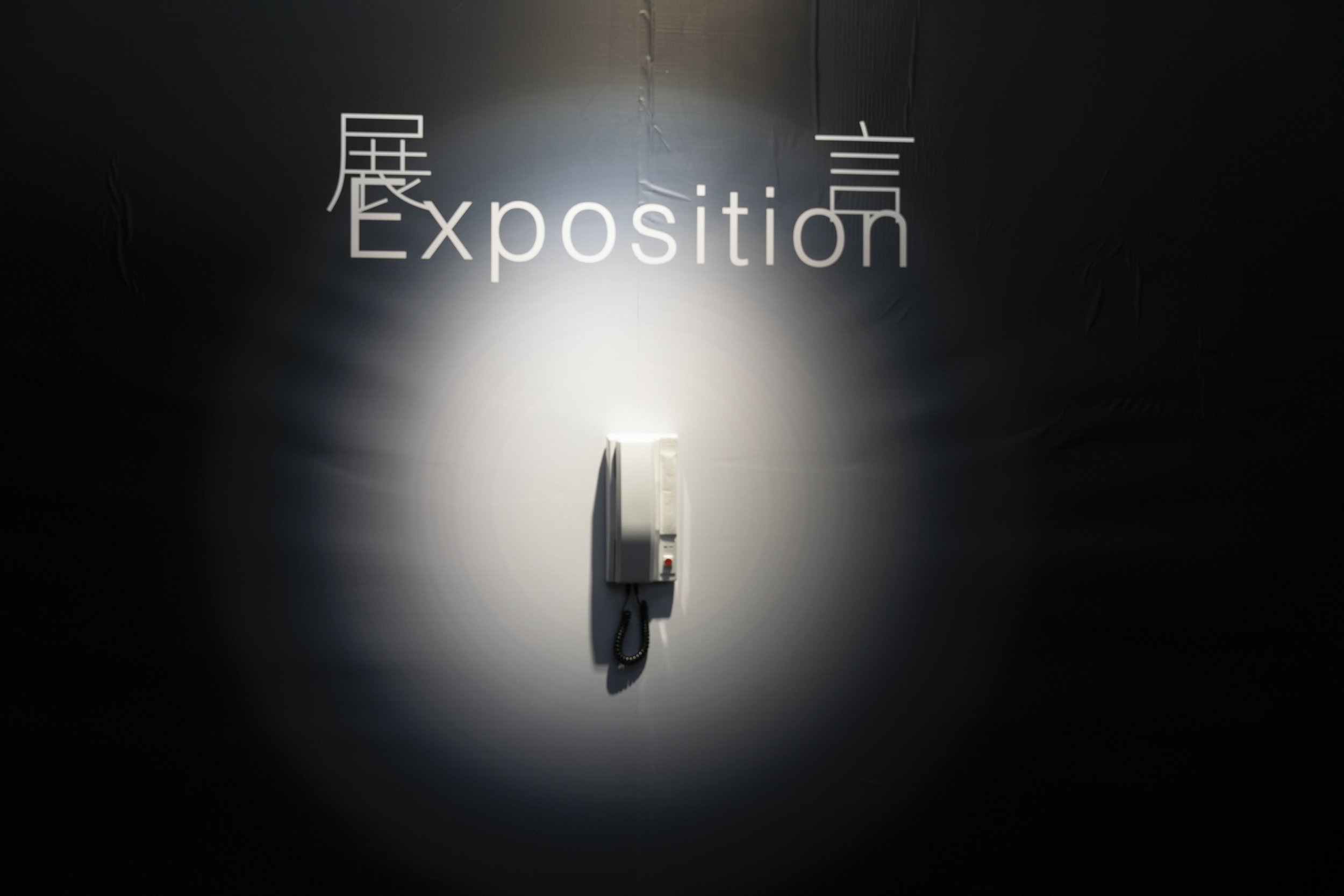
Declaration of a Decentralized Methodology
Declaration of a Decentralized Methodology
Interactive installations, telephones, telephone booths, 2024.
Texts are replaced by telephones, and the declarative center is replaced by one-on-one dialogue, where attempts at clarity are replaced by the fluid exchange of information between both parties.
This is a declaration about the possibilities of pathways, using a decentralized methodology to narrate and communicate, rather than establishing a touted result of decentralization through inflated, diverse narratives, which in essence are different forms of centrality.
The language spoken here is not merely the expression of one's own will, but rather fuel for the burning of the other. It does not view the other's discourse as an oppressive structure, but as fuel for one's own combustion and reflection. Meaning is not delivered and transmitted but generated in the listener's mind. This is precisely what the symbolic elements used in this work aim to convey, replacing declarative statements with direct conversations between the artist and the curator. The work itself becomes a declaration.
去中心化方法论宣言
交互装置,电话机,电话亭,2024
文本被电话机取代,宣告性的中心于此被一对一对话的形式取代,试图明确的内容被双方之间流变的信息取代。
这是一场关于路径可能性的宣言,使用去中心化的方法论去叙述与传媒,而非通过虚浮的多元化叙述建立一个标榜为为去中心化的结果,而其实质是中心的不同形态。
于此吐出的语言不仅仅是自身意志的贯彻,而是提供给对方燃烧的柴薪。不将对方的话语视为压迫性结构,而是自身燃烧与思考的养料。意义并非贯彻与传递,而是在听者的脑海中生成。这正是这一作品之中所使用的象征性符号所叙述的部分,用和策展人直接的通话取代宣告性的展言。而其本身成为了一件宣言性质的作品。
Necessity - Dynamism against dynamism
In the prevailing context of subjectivist philosophical thought, dynamism becomes the visibly sole criterion, and the inclination towards decentralization is a direct manifestation of dynamism – "I can do more, I should do more."
However, dynamism also leads to its own impotence. A perverse structure emerges within the broader context of liberalism – the emphasis on boundaries between subjects clashes with the emphasis on subject dynamism. The emphasis on respecting others' freedom and asserting one's own freedom is not just a related relationship but also an antagonistic one. While dynamism is described in macroscopic terms through the establishment of boundaries, excessive emphasis on boundaries at the personal level may imply a perversion. How does this tendency manifest in identity movements? This aspect of manifestation has been discussed as early as in Gustave Le Bon's "The Crowd," where individual dynamism is engulfed by movements that claim to fight for individual dynamism. The antagonistic emphasis on subjectivity and dynamism limits itself.
Chaotic forces, leaderless, tumble across the wasteland. In this emphasis on individual discourse, the individual is ironically the most flattened.
Contemporary art emerged in precisely such a soil, from its inception it was engulfed in a torrent of criticism and opposition, placed in a utilitarian position, treated more as material than as an object, and artists were ensnared within it, just as all narratives are ensnared in subject recognition in subjective philosophy. Within this, all process-oriented aspects, treated as possible objectives, are continually marginalized in the macroscopic context.
Allow me to propose this polemic: Is the lineage of subjective philosophy itself a direct manifestation of "obsession"? Continuously throwing out parts that it cannot discuss, and attempting to construct a complete framework of the world with increasingly smaller residues. Isn't the crisis it faces in confronting real societal issues a result of its own structural deficiencies? Whether it's the scarcity of signifiers or the signifiers of scarcity, modern philosophy is constantly facing its own impotence and deficiencies, yet it still needs to bear the ideological function. Is accepting its incompleteness also a choice? Its emphasis on subjectivity has already formed a paradoxical structure in social practice. There is no external freedom without confrontation, its essence is a confrontational relationship, the priority of absolute subjectivity in narrative methods, such as "you can be anyone, do anything," constantly short-circuits itself, not to mention the linguistic structure that has already fallen into paradoxes, such as why emphasize "A and B" being the same if the narrator truly believes they are equal?
Precisely because the decentralization has utterly failed in its purpose, it forces me to turn it into a methodology for thinking and articulating. Is there a possibility of extracting oneself from the vortex of "what is" and "what is not"? After deconstructionism, there is no longer the possibility of constructing solid judgment criteria in the present moment. All postmodern discussions and confrontations result in a paradoxical impotence of being unable to judge and therefore unable to distinguish right from wrong. By emphasizing the body and sensations, expression rather than delivery, continuous and universal criticism, dialogue rather than declaration, and so on, let the river flow. This fluidity itself can become an object of enjoyment, rather than focusing all attention on "where the river will flow."
The language spoken here is not merely the expression of one's own will, but rather fuel for the burning of the other. It does not view the other's discourse as an oppressive structure, but as fuel for one's own combustion and reflection. Meaning is not delivered and transmitted but generated in the listener's mind. This is precisely what the symbolic elements used in this work aim to convey, replacing declarative statements with direct conversations between the artist and the curator.
必要性-能动性反对能动性
在这个主体性哲学思想大行其是的语境下,能动性成为肉眼可见的唯一标准,而去中心化倾向即是能动性倾向的直接体现形式——我能做更多,我应该做更多。
但同时能动性也在导向自身的无能,一种倒错结构在泛自由主义(liberalism)语境下普遍形成-对于主体间边界的强调与对主体能动性的强调之间,对他人尊重他人自由的强调和自身自由的强调不仅仅是相关的关系,同时是一种对抗性关系。从宏观上描述能动性是借由边界的设立扩大的,但从个人而言对边界的过分强调是否同时意味着倒错的发生。从此导向的问题在身份化运动之中如何显现?这显现的部分早在乌合之众之中便有提及,即个人的能动性淹没在宣称争取个人能动性的运动之中。对主体性与能动性的对抗性强调在限制自身。
一团团混沌而无领导的力在荒原上翻滚。在这片强调个人的话语体系之中,个人恰恰是最被扁平化的东西。
当代艺术诞生的正是那样一片土壤,其自诞生起便被裹挟入了批判性与对抗性的洪流之中,放置于工具化的位置之上,其更多的作为材料而非对象对待,艺术家也被裹挟其中,正如主体性哲学之中一切叙述为主体识别裹挟一般。在其中所有的过程性本身作为目的的可能性在宏观语境下不断被边缘化。
在此请允许我提出这一暴论:主体性哲学脉络本身即是“魔怔”一词的直接体现呢?其不断的将其所不能讨论的部分抛出,又尝试用越来越小的剩余建构世界的完整框架。其面对现实社会时的危机不正是由其自身结构的残缺产生的吗?无论是能指的匮乏还是匮乏的能指,现代哲学无时无刻都在面对着自身的无能与残缺,但其又依然需要承担意识形态性的职能。接受其不完整性是否同样是一种选择?其主体性强调在社会实践之中已然形成了一种悖论性的结构,不存在没有外部的自由,其本质是一种对抗关系,绝对的主体性优先叙述方式“你可以成为任何人,做任何事”自身不断发生短路,更不用说所谓“女性和男性一样可以成为任何人做任何事”这种在语言结构层面就已然陷入悖论的结构了,如若叙述者真实相信两者等同,又为何强调“A和B”一样?
正因去中心化在目的上的彻底失败,逼迫我转向将其作为一种方法论进行思考和阐述。是否存有将视线从“是什么”与“不是什么”的涡旋之中抽出的可能性?解构主义之后,不再存有坚实评判标准建构的可能的当下,所有后现代式讨论与对抗的结果都是陷入一种无以评判进而无法区分对错的二律背反式的无能。通过强调身体与感受,表达而非交付,持续性与普遍性批判,对话而非宣告等等一切,让河水流动,这种流动性本身可以成为享乐的对象,而不仅仅是将全部的注意力投于“河水将往何方”之上。
于此吐出的语言不仅仅是自身意志的贯彻,而是提供给对方燃烧的柴薪。不将对方的话语视为压迫性结构,而是自身燃烧与思考的养料。意义并非贯彻与传递,而是在听者的脑海中生成。这正是这一作品之中所使用的象征性符号所叙述的部分,用和策展人直接的通话取代宣告性的展言。
